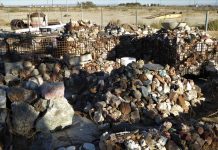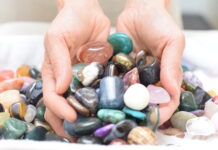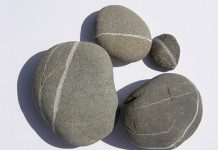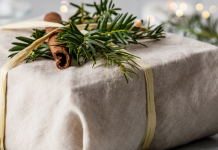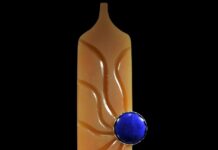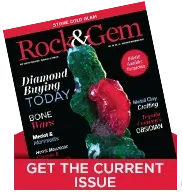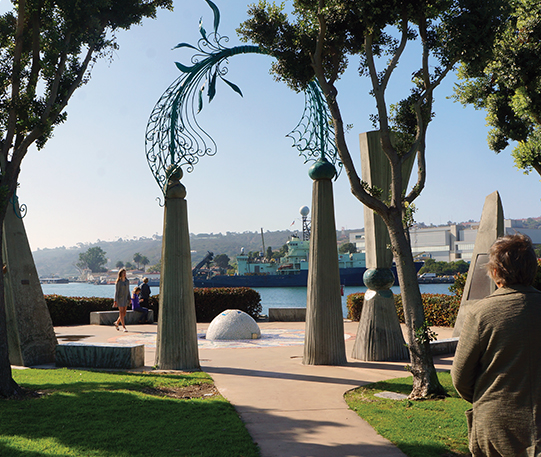
By Helen Serras-Herman
Did you know that the Pearl of the Pacific was created in 1998 as a symbol of friendship and unity between the United States, Mexico, China and Russia? The four are Pacific Rim countries, and the Pearl of the Pacific is one of six parks created by the Pacific Rim Park Project, a non-profit association created to strengthen the cultural unity between these countries’ peoples. The parks, created over the past 20 years, are designed and built by architecture students under the supervision of leading artists and urban planners. Each park includes a pearl element in its design, as the creators envisioned the Pacific draped in a “string of pearls” in contrast to a “ring of fire.”
When my husband, Andrew, and I visited San Diego in November 2019, I had planned to meet with my fellow gem artist Nancy Arthur-McGehee and visit her studio. After connecting with Nancy and before heading to her studio, she drove us to several places in the city, beaches and neighborhoods, a visual feast of San Diego.
Our first stop was at one of her favorite locations, the Pacific Rim Park Pearl of the Pacific. It is a rather small park, on the waterfront, at the tip of Shelter Island, one of my favorite places to stay and visit. Shelter Island is on the Point Loma peninsula. The architectural sculptures for the Pearl of the Pacific park are created by artist James T. Hubbell, who was the artistic director, and Kyle Bergman, the construction coordinator.
I always love to be surprised about where to find inspiration and stimulation. Artwork created by other artists is always a good source, especially art I would not envision doing myself, but admire for its innovation, thematic approach, and materials.
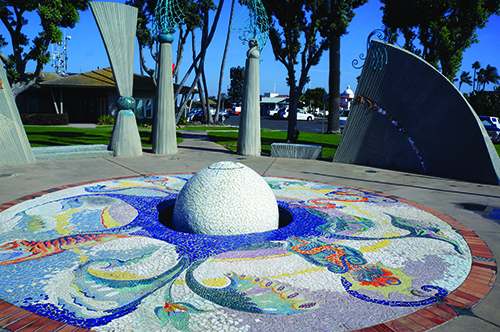
The Pearl’s Plentiful Features
The Pearl of the Pacific blends the artistic traditions of the four featured countries with its Pearl Fountain. The fountain includes two concrete wall arches that suggest the form of an open Chinese fan with grooved lines imitating a fan’s slats and an intricate, forged wrought iron design archway reminiscent of Russian lacework.
There is a beautiful, colorful mosaic circle in the center of the park, with a “pearl” fountain centerpiece, constructed with all white tiles. The centerpiece is surrounded by multicolored mosaics featuring the park’s four elements that symbolize the Pacific Rim’s four quadrants: the Chinese dragon, an inspirational American shorebird, a Russian Siberian tiger, and the Mexican Quetzalcoatl, the mythical winged serpent.
Mosaic art is the decoration of a surface that is made of closely-set, usually multicolored small pieces of material, such as stone, mineral, glass, tile, or shell. The mosaic pieces are applied onto a flat surface that has been prepared with an adhesive. Mosaics differ from inlays, for which the surface has been hollowed out, and they differ from intarsia, for which the components interlock like a jigsaw puzzle to create the design. Mosaic is a pictorial art form achieved with color gradation and shading. The components may be evenly-sized, like the ancient tesserae (squares or cubes), or uneven, as is the case of the Pearl of the Pacific.
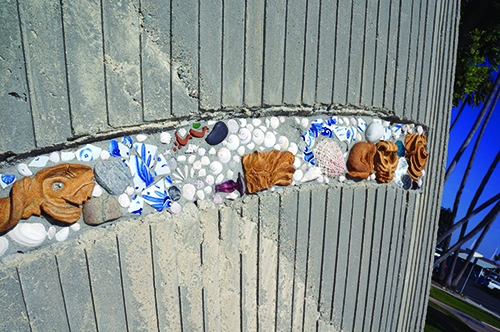
Besides the striking mosaic circle, there is a recessed band within each of the curved concrete walls. The band consists of inlaid elements such as beach pebbles, geode slabs, broken blue-and-white chinaware shards, various shells, and small sculptures carved in indigenous manzanita wood. These relief sculptures take the shape of birds heads, figures, hearts, snakes, and roses. I was truly taken by the assortment of materials, an amalgamation that I would probably have never considered mixing in one artwork. But that was exactly their beauty. The various heights and natural textures add dimension and intrigue, a cultural blending of styles and motifs. I wish there was more information provided about the depiction of each of the sculptural elements and patterns and why they were chosen. The inlaid bands also add focus to the vast emptiness of the concrete wall.
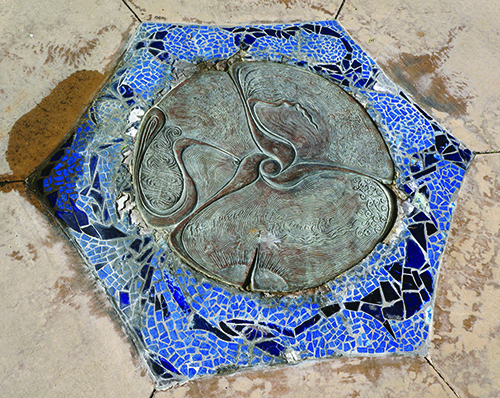
The Artist Behind the Work
James Hubbell is an award-winning, California-living artist, architectural designer, poet, jeweler, and sculptor. His portfolio is extensive, as he’s worked in almost every material, such as wood, stone, metal, glass, clay, and plastics. He is widely known for his organic style buildings. His art and architecture have been embodied in homes, schools, gardens, pavilions, nature centers, monasteries, museums, and peace parks worldwide. Both nature and landscape play a central role in Hubbell’s art.
Nancy shared with me that James Hubbell is an artist whose work she has followed for a long time both in San Diego and Japan, as well as that Hubbell’s work has been very influential and inspirational to her in her artistic development.
By sharing this unique architectural and sculptural artwork, I hope that I can inspire you to create art beyond the traditional media separations, even outside our gem art segregated styles of cabbing, faceting, carving, mosaic, and gem sculptures.
For more information about the Pearl of the Pacific Park in San Diego and the other international parks, visit pacificrimpark.net/san-diego. And to view more of Hubbell’s artwork, visit jameshubbellart.com/.
Author: Helen Serras-Herman
 Helen Serras-Herman, a 2003 National Lapidary Hall of Fame inductee, is an acclaimed gem sculptor and gemologist with over 37 years of experience in unique gem sculpture and jewelry art. Visit her website at www.gemartcenter.com and her business Facebook page at Gem Art Center/Helen Serras-Herman.
Helen Serras-Herman, a 2003 National Lapidary Hall of Fame inductee, is an acclaimed gem sculptor and gemologist with over 37 years of experience in unique gem sculpture and jewelry art. Visit her website at www.gemartcenter.com and her business Facebook page at Gem Art Center/Helen Serras-Herman.
If you enjoyed what you’ve read here we invite you to consider signing up for the FREE Rock & Gem weekly newsletter. Learn more>>>
In addition, we invite you to consider subscribing to Rock & Gem magazine. The cost for a one-year U.S. subscription (12 issues) is $29.95. Learn more >>>



